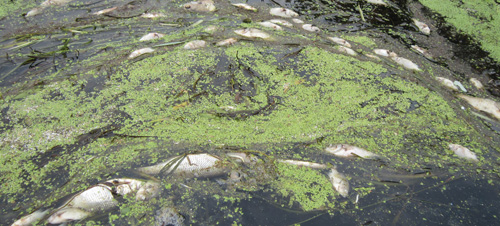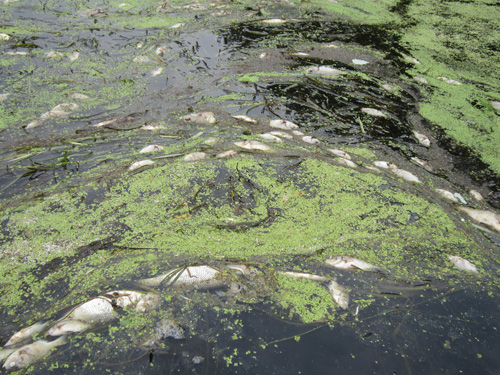

Courtesy Allan Fierce
July 31, 2013
By Nancy Arsenault
The recent near record high temperatures and the prolonged hot weather have combined to induce a “fish kill” in the shallow Assabet River. According to the environmental organization OARS, there are hundreds, if not thousands of fish who succumbed under these extreme environmental conditions that occurred earlier this month.
These dead fish are now floating atop the water, many in large massed groups at various levels of decay. They are caught in grasses and weeds or grouped along the shorelines. Others are floating singly atop the water, attracting flies as they decompose in the sun, with an ensuing odor that is becoming more pungent each day.
This past weekend, lifeguards at the Town Beach on Lake Boon were removing dead fish from the swimming area and shoreline, indicating that the fish kill has also extended to areas of the Lake.
The fish kill was first discovered and reported by Stow resident Allan Fierce a little more than a week ago, after he had been out on the River in a canoe as part of a volunteer contingent pulling water chestnuts from the water. “It was on the entire stretch of River from the Collings Foundation to the large shallow bay about 600 yards upstream where we did most of our pulling,” said Fierce of the dead fish he observed. Later investigation shows the fish kill extended further in both directions.
“The fish ranged in size from 2” fingerlings to as large as about 10″ long,” said Fierce. Based on the timing of an earlier visit to the same point in the River, Fierce estimates the fish kill to have occurred between a specific four day period two weeks ago, during the extended heat wave.
While humans can escape the heat in many ways, there are few options for fish and wildlife, even for those who live in a watery environment. OARS officials said that Massachusetts Fish & Wildlife concurred with OARS’ determination that prolonged hot weather, with temperatures hitting 100°F on July 19th, is the likely cause of the fish kill.
According to OARS Staff Scientist Sue Flint, “After two days of much cooler weather, we measured afternoon water temperatures and they were still over 86°F in the area downstream of the fish kill. Where the river is shallow and slow-moving, afternoon water temperatures can reach lethal conditions. 93°F is lethal for almost all species of fish.”
“The effects of high water temperatures and the accompanying lack of oxygen in the water is what suffocates the fish,” said Alison Field-Juma, Executive Director of OARS. “This is most common in shallow lakes and ponds, but can also occur in stressed rivers. Even though there is less duckweed on the surface than previous years, high nutrient levels in the Assabet River continue to feed the algae and rooted plants that use up the oxygen that fish need to survive.”
Field-Juma believes that the changing rainfall patterns and weather extremes forecast worsening conditions for fish and other wildlife within the River ecosystem. “Last year was the hottest year in Massachusetts out of a 118-year record. Over the past 64 years, the intensity of rainfall has increased dramatically in New England, resulting in more floods but also less recharge of the cool and clean groundwater that feeds the rivers in the summer. “Recharging stormwater into the ground will make a big difference, and reducing nutrient pollution through decentralized wastewater treatment with ground discharges will also help. Both these things require longer-term investments than we are used to making,” said Field-Juma.
In the meantime, the remaining weeks of summer will find portions of the Assabet River littered with masses of fish, slowly decomposing. Massachusetts Fish & Wildlife representatives said there is really nothing they can do about removing such a vast number of fish, and nature will be allowed to take its course to slowly break down the fish bodies and return them back to the river system.